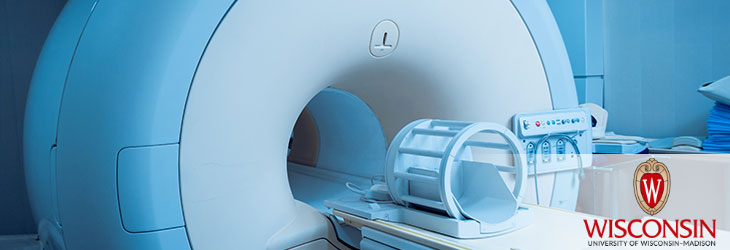Radiation Therapy

Elastographic Imaging of Soft Tissue in Vivo
WARF: P02153US
Inventors: Tomy Varghese, James Zagzebski, Udomchai Techavipoo, Quan Chen
The Wisconsin Alumni Research Foundation (WARF) is seeking commercial partners interested in developing a simple and effective way of monitoring the RF ablation of soft tissue inside the body.
Overview
Elastography is a new ultrasound imaging technique that detects and images the local stiffness properties of tissues during compression. Three-dimensional (3-D) elastography provides a way to visualize cancerous tumors, track changes in tumor size over the course of therapy and monitor the treated margins of a tumor during radio frequency (RF) ablation.
In RF ablation, large differences in stiffness between the ablated tumor and surrounding normal tissues allow elastographic imaging of the ablated region’s size, volume and position. Accurate computing of these parameters may determine the success or failure of the RF ablation procedure.
Despite its promise, 3-D elastography has rarely been used to image tissues and organs inside the body due to their tendency to slip laterally when compressed from the outside.
In RF ablation, large differences in stiffness between the ablated tumor and surrounding normal tissues allow elastographic imaging of the ablated region’s size, volume and position. Accurate computing of these parameters may determine the success or failure of the RF ablation procedure.
Despite its promise, 3-D elastography has rarely been used to image tissues and organs inside the body due to their tendency to slip laterally when compressed from the outside.
The Invention
UW-Madison researchers have now discovered that by using an RF ablation probe to internally compress tissue, they can generate 3-D elastographic images of the liver in vivo. Thus, this technique provides a simple and effective way of monitoring the RF ablation of soft tissue inside the body, without the lateral slippage caused by external compression. Elastography may be performed either during RF ablation or after the procedure is complete.
Applications
- Monitoring tumor margins during RF ablation
Key Benefits
- Allows in vivo imaging of tumors and other structures embedded in soft tissues such as the liver
- Applies precise and controlled compression to the tissue or organ of interest with minimal lateral slippage
- Unlike conventional ultrasound imaging, provides accurate images of tumor margins during RF ablation
- By alleviating the need for external compression during elastography, should increase patient comfort during procedures
- Aids decisions on treatment modalities, probe placement and the number of treatments required
- By providing information on the volume, size and shape of the treated zone during RF ablation of cancerous tumors, allows verification that the ablated region fully encompasses the tumor
- Allows in vivo imaging of abdominal organs
- Well-suited to ultrasound imaging, the modality most commonly used for RF ablation probe guidance
Additional Information
For More Information About the Inventors
For current licensing status, please contact Jeanine Burmania at [javascript protected email address] or 608-960-9846